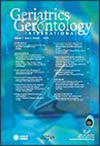Association of chronic low back pain and knee pain with subjective fatigue incidence among community-dwelling older adults: A prospective cohort study
Abstract
Aim
Fatigue is a common health problem in older adults. Chronic pain is associated with fatigue. However, the longitudinal association between chronic pain and the incidence of subjective fatigue among community-dwelling older adults remains unclear. Therefore, this study aimed to investigate the association between chronic pain and subjective fatigue using prospective data.
Methods
The study included 2060 community-dwelling older adults (age 70.5 ± 6.4 years; male: n = 944) without subjective fatigue at baseline. Chronic pain and other data were assessed at baseline. Subjective fatigue incidence was investigated at the follow-up examination 2.5 years from baseline.
Results
In total, 389 (18.9%) reported chronic low back pain, 322 (15.6%) reported chronic knee pain at baseline, and 342 (16.6%) reported subjective fatigue at follow-up examination. A logistic regression analysis showed that the odds ratio for the incidence of subjective fatigue in participants with chronic low back pain had a higher odds ratio for the incidence of subjective fatigue compared to participants without chronic low back pain (odds ratio = 1.71, 95% confidence interval = 1.29–2.26). Chronic knee pain had a higher odds ratio for the incidence of subjective fatigue compared to participants without chronic knee pain (odds ratio = 1.63, 95% confidence interval = 1.21–2.20).
Conclusions
These results suggest that chronic low back pain and knee pain increase the risk of subjective fatigue incidence. These findings emphasize the contribution of chronic pain to fatigue among older adults. Therefore, intervention studies are required to prevent subjective fatigue in participants with chronic pain. Geriatr Gerontol Int 2025; 25: 398–402.

 求助内容:
求助内容: 应助结果提醒方式:
应助结果提醒方式:


